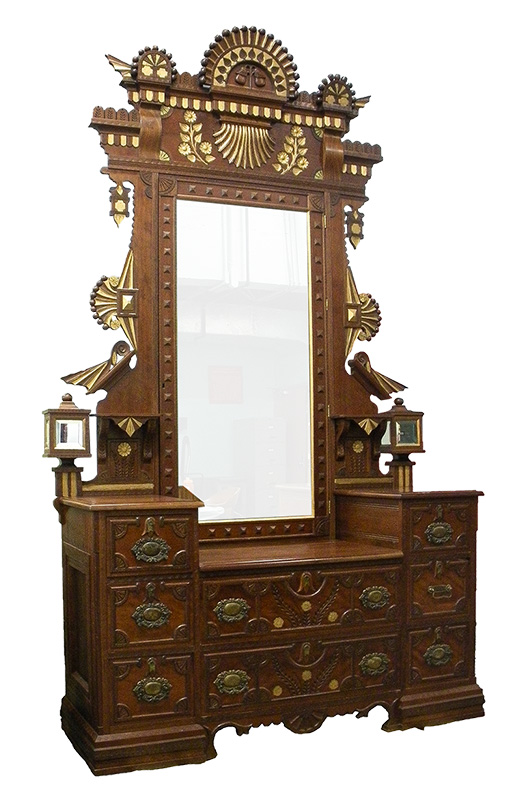Looking Again at Tennessee Furniture
Click on images to enlarge them and view captions.
by Candice Roland Candeto
Once overlooked in early decorative arts scholarship, Tennessee furniture promises fruitful opportunities for further study.1 This material is as wide-ranging and diverse as the state itself, from the idiosyncratic inlay of the East Tennessee mountains to the products of Mississippi River trade that made their way from ports into Memphis homes. Tennessee furniture is constructed from native woods and imported materials, shipped from factories or made in local shops, and crafted by lifelong residents and journeymen passing through. Each object connects many Tennesseans, from the hands that harvested the trees to those who preserved objects for future generations, including those whose stories are omitted from the written record.
With the roots of its collection stretching back to the 1820s, the Tennessee State Museum has played a key role in preserving and interpreting the state’s unique decorative arts traditions. The Museum’s vast furniture collection ranges from objects that predate statehood to contemporary creations. A new exhibition reflects on where the story of Tennessee furniture has been and is going. Emphasizing the human aspects attached to 45 featured selections, the exhibition invites new investigations into the Museum’s collection and the medium more broadly.2
From the era when Tennessee was considered the western frontier, rich cabinetmaking traditions flourished, resulting in exuberant regional styles, innovative interpretations for local markets, and masterworks to furnish fine frontier homes. When cabinetmaking shops can be identified, vibrant stories emerge. John C. Burgner is one of Tennessee’s best documented cabinetmakers. Burgner was born in Virginia, relocating to northeast Tennessee in 1810 with his family as a teenager. He operated his business from about 1818 into the 1850s in Tennessee and North Carolina. A Burgner secretary in this exhibition (figure 1) is one of the most exceptional pieces of furniture made in the early South. Appearing to be a standard desk (albeit with brilliant burl veneer) when closed, a quill installed inside the top drawer strums a zither when opened, producing a string of musical notes. Burgner may have included this feature as a novelty or as a sort of security alarm.
Beyond the visual (and even auditory) delights of Tennessee furniture are narratives of the countless individuals whose experiences are illuminated through their craft. Most furniture produced in early Tennessee was the product of many hands, from those who supplied the materials to the craftspeople who finished a surface: men and women, free and enslaved. Importantly, Burgner’s account books identify several craftspeople in his shop by name. Some, including Rice C. Spears and Samuel Wycough, carried their skills westward, broadening the influence of Tennessee cabinetmaking.3 Black craftsperson Richard “Dick” Poyner purchased his freedom from slavery through the sale of his famed ladderback chairs (figure 2). Poyner’s expert work with green wood resulted in sturdy chairs widely celebrated in his day and today.4
Tennessee has been and remains an epicenter for craft, and some of the nation’s most celebrated contemporary furniture makers live and work in the state. Generations of craftspeople have flocked to the Arrowmont School of Arts and Crafts in Gatlinburg, for example, where they find inspiration and training in the mountains of East Tennessee. Some of today’s makers reinterpret historic forms for modern homes, keeping traditional skills alive. Other artists working in wood push the boundaries of furniture, including Craig Nutt, whose vegetable-inspired creations (figure 3) are sought by collectors today.
An appreciation for the artistry of Tennessee furniture and close examination of its history combine to tell the stories of this complex state. A compelling example is a late-19th-century dresser (figure 4) by Black craftsperson Lewis Buckner, among the most exceptional furniture makers from Tennessee. Buckner was enslaved at birth and, after emancipation, trained as a cabinetmaker in Sevier County near Gatlinburg.5 His dresser uses elements of the Aesthetic Movement, with mirrored “lantern” finials and carved pears, wheat, shells, and bellflowers, hand-punched snowflake borders, and more. The remarkable object is testament to Buckner’s immense skill as an artist, craftsperson, and entrepreneur. This embodiment of Buckner’s creativity teaches us more about the man and his lived experience than a written account alone ever could.
- The Art and Mystery of Tennessee Furniture authored by Nathan Harsh and Derita Coleman Williams and edited by C. Tracey Parks (Tennessee Historical Society and Tennessee State Museum Foundation, 1988) was the first major survey of early Tennessee furniture, and remains the only such work completed since. Dedicated scholarly attention to the subject began in the 1970s and included Made in Tennessee: An Exhibition of Early Arts and Crafts at Cheekwood Estate & Gardens in 1971.
- The Tennessee State Museum thanks Dr. Daniel Ackermann, Mike Bell, Dr. Tiffany Momon, and C. Tracey Parks for their assistance in the creation of this exhibition.
- Daniel Kurt Ackermann, “Cabinetmaking in the Southern Backcountry: The Ledger Book of John C. Burgner” MESDA Journal, Vol. 36 (2015).
- Western Weekly Review (Williamson County, TN), November 16, 1849. Thanks to Rick Warwick for his extensive research.
- Annabeth Hayes Dooley, “A Smoky Mountain Home: The Story of Cabinetmaker Lewis Buckner,” Thousands of Stories, Tennessee State Museum, February 17, 2022. Thanks also to Dr. Tiffany Momon for research and interpretation on Buckner’s life and work.
Candice Roland Candeto is the Senior Curator of Fine and Decorative Art at the Tennessee State Museum and the curator of Tennessee Furniture: Selections from the State Museum Collection, open through early 2025.
A print version of this article was published in The Magazine of the Decorative Arts Trust, one of our most popular member benefits. Join today!




